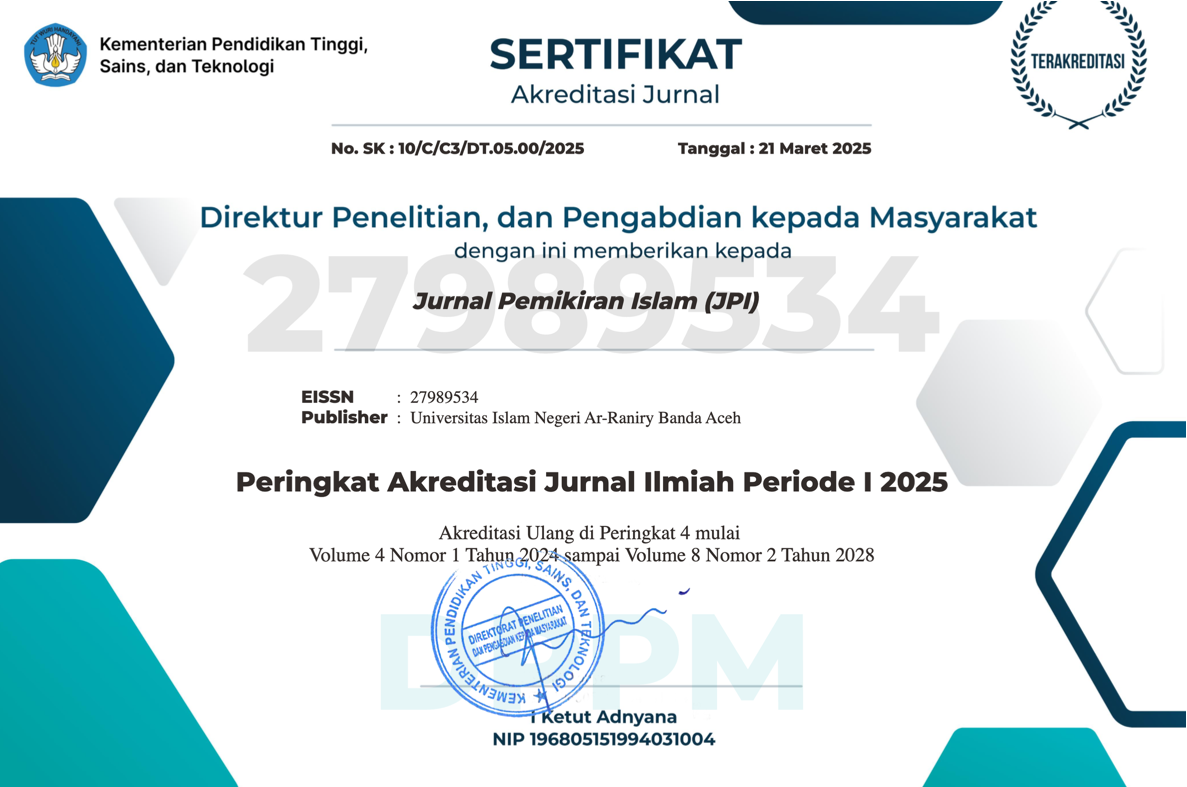Reconstruction of Gender Thinking between Men and Women as Different Identity in Islam
DOI:
https://doi.org/10.22373/jpi.v3i1.16854Keywords:
Reconstruction, Gender, EqualityAbstract
People often interpret gender as the distinction between the sexes of men and women. In English, gender means sex, whereas Webster's New World Dictionary defines gender as the visible differences in values and behavior between men and women. The current understanding of gender often leads to a misunderstanding of its true meaning, resulting in frequent discrimination against women. This article aims to reexamine the established understanding of gender. The study adopts a qualitative descriptive approach to describe, explain, and address the existing issues. The findings of this study demonstrate that men and women, as distinct identities, can attain equality in Islam. Biological differences do not justify a higher or lower position between the two genders. In the Islamic context, there are no specific restrictions preventing women from participating in the public sphere, especially considering the evolving times. The Indonesian context itself exemplifies an increasing presence of women in politics and other domains without violating religious morals.
Downloads
References
Apriliani, Devi Rizki, Adzkiya Zayyan Mauizah, Dafis Heriansyah, Sholeh Utomo, and Siti Chodijah. 2021. “Gender Dalam Perspektif QS. An-Nisa Ayat 34.” Jurnal Riset Agama 1(3):188–98. doi: 10.15575/jra.v1i3.15129.
Cranny Francis, Anne, Wendy Waring, Pam Stavropoulos, and Joan Kirkby. 2003. Gender Studies: Terms and Debates. Palgrave Macmillan.
van Doorn-Harder, Nelly. 2019. “A Genealogy of Islamic Feminism: Pattern and Change in Indonesia by Etin Anwar.” Indonesia 108(1):143–45. doi: 10.1353/ind.2019.0020.
Fadli, Muhammad Rijal. 2021. “Memahami Desain Metode Penelitian Kualitatif.” HUMANIKA 21(1):33–54. doi: 10.21831/hum.v21i1.38075.
Fakih, Mansour 1953-2004. 2008. Analisis Gender Dan Transformasi Sosial/Mansour Fakih. Yogyakarta: Pustaka Pelajar.
Hunawa, R. 2018. “Kedudukan Suami-Istri (Kajian Surah An-Nisa).” Potret Pemikiran 22 no 1:32–45.
John, W. Santrock. 2012. Life Span Development 13’Edition: Perkembangan Masa Hidup Jilid 1. Jakarta: Erlangga.
Matthews, Aisha. 2018. “Gender, Ontology, and the Power of the Patriarchy: A Postmodern Feminist Analysis of Octavia Butler’s Wild Seed and Margaret Atwood’s The Handmaid’s Tale.” Women’s Studies 47(6):637–56. doi: 10.1080/00497878.2018.1492403.
Nasr Hamid Abu Zayd. 2003. Dekontruksi Gender. Cetakan Pe. McGill.
Nila Sastrawati. 2018. Analisis Gender Dan Politik Perspektif Post-Feminisme. Makassar: Alauddin Press Makassar.
Supriyadi, Tedi, J. Julia, and Endis Firdaus. 2019. “The Problems of Gender Equality: A Reconstruction of Islamic Doctrine.” Journal of Social Studies Education Research 10(2):91–110.
Widiawati, Nani, and Nurkhopipah Nurkhopipah. 2021. “Analisis Problem Gender Pada Sinetron Dunia Terbalik Dalam Perspektif Nasaruddin Umar.” An-Nisa’ : Jurnal Kajian Perempuan Dan Keislaman 14(1):88–107. doi: 10.35719/annisa.v14i1.58.
Wood, Julia T. 1994. Gendered Lives: Communication. Lyn Uhl.
Downloads
Published
Issue
Section
License
Authors who publish in Jurnal Pemikiran Islam agree to the following terms:
- Authors retain copyright and grant the journal right of first publication with the work simultaneously licensed Attribution-NonCommercial-ShareAlike 4.0 International (CC BY-NC-SA 4.0) that allows others to share the work with an acknowledgment of the work's authorship and initial publication in this journal.
- Authors are able to enter into separate, additional contractual arrangements for the non-exclusive distribution of the journal's published version of the work (e.g., post it to an institutional repository or publish it in a book), with an acknowledgment of its initial publication in this journal.
- Authors are permitted and encouraged to post their work online (e.g., in institutional repositories or on their website) prior to and during the submission process, as it can lead to productive exchanges, as well as earlier and greater citation of published work. (See The Effect of Open Acces)














